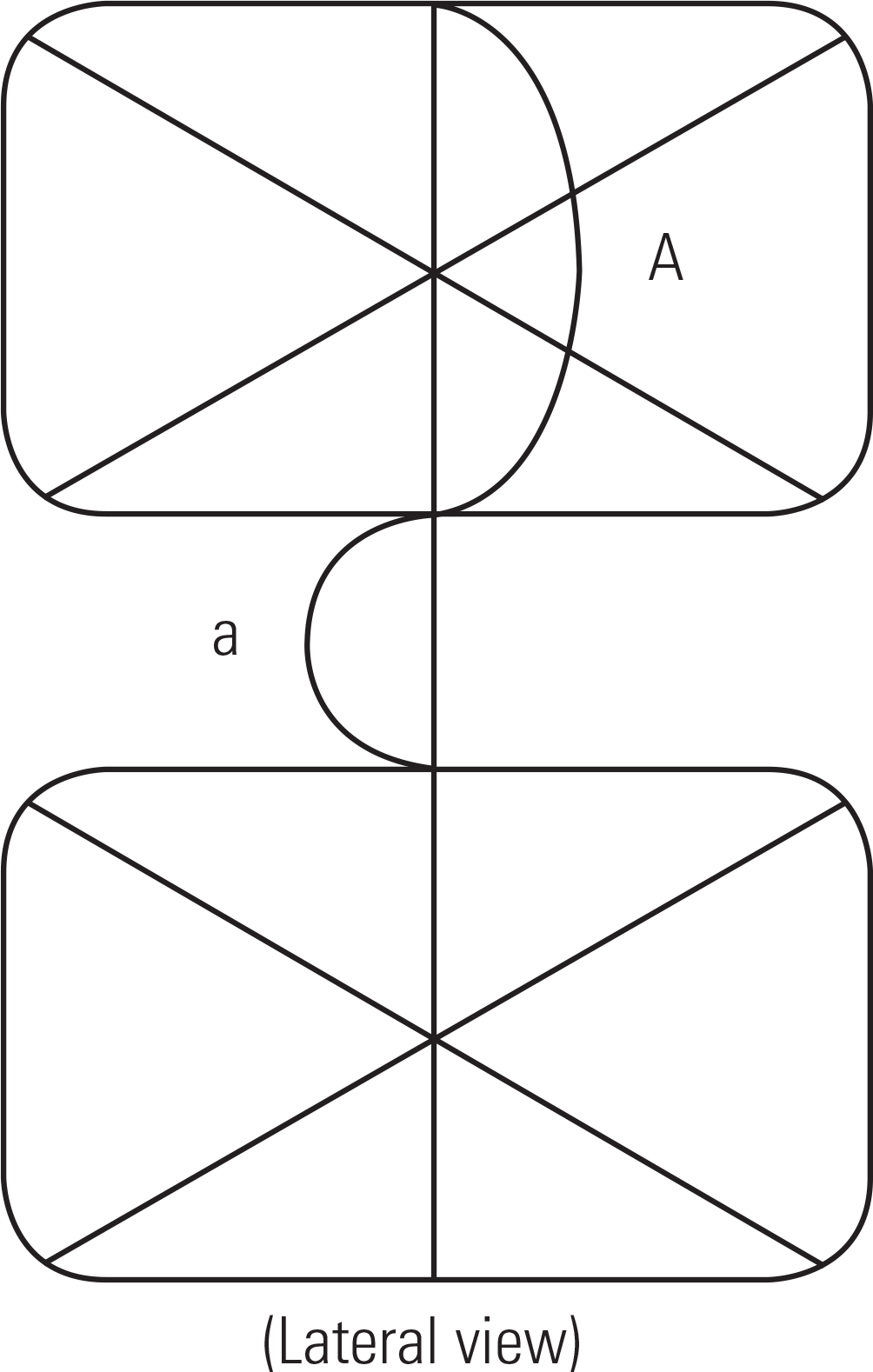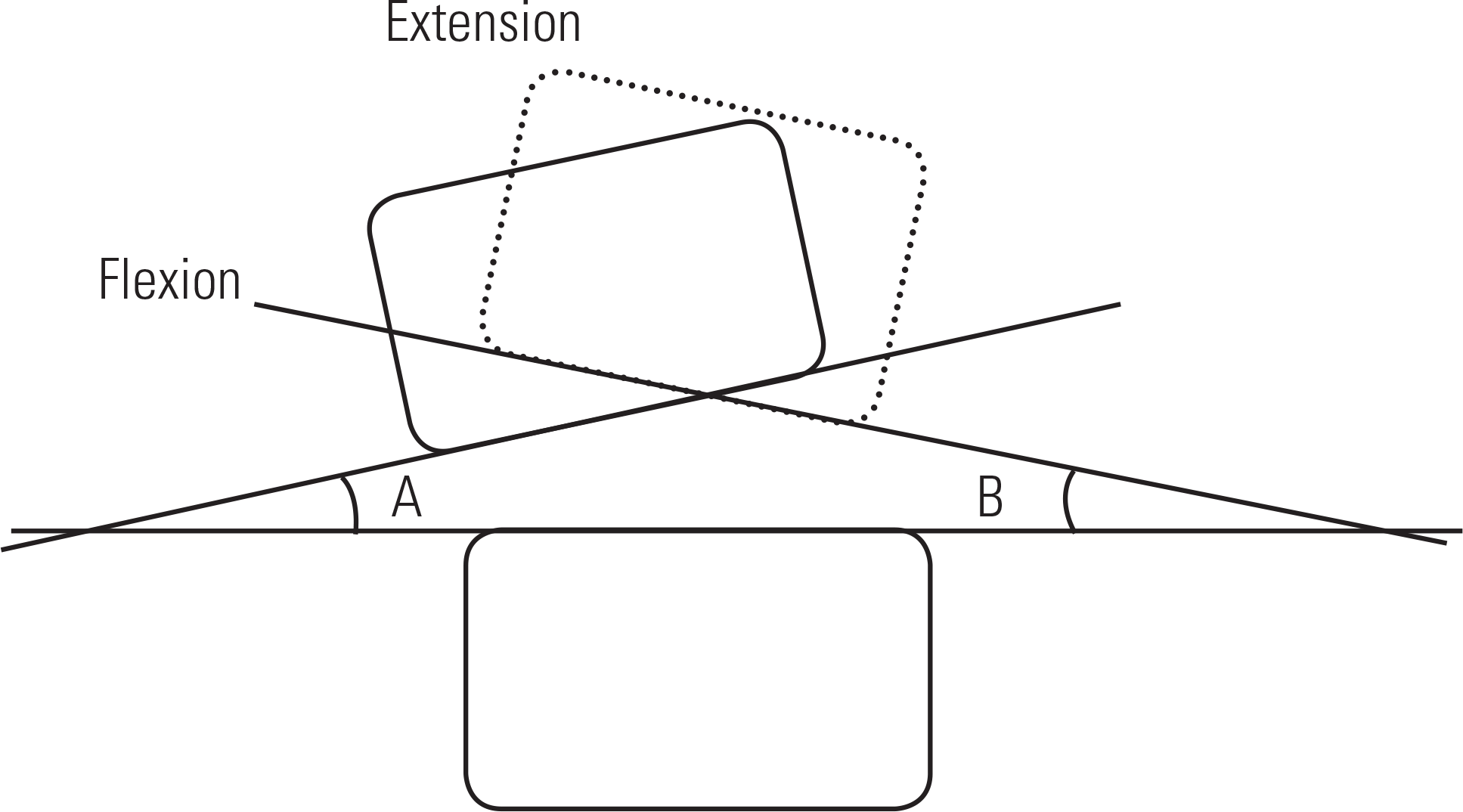Abstract
Objective
To analyze the effectiveness of percutaneous endoscopic lumbar discectomy (PELD) for adjacent lumbar disc herniation through radiologic evaluations.
Summary of Literature Review
PELD minimizes posterior structural damage, allowing rapid rehabilitation.
Subjects and Methods
This study was conducted on 45 patients who were followed up for 1 year after PELD for adjacent lumbar disc herniation from March 2014 to February 2016. The modified Macnab criteria, the modified Suezawa and Schreiber score (MSS score), and visual analogue scales for the back (VAS-B) and legs (VAS-L) were evaluated. The disc height ratio and segmental angulation change were compared before posterolateral fusion and before PELD. Moreover, spinal stenosis was confirmed on magnetic resonance imaging (MRI) before PELD.
Results
Based on the modified Macnab criteria, 53.3% patients received an evaluation of at least “good,” and the mean MSS score improved from 4.77 to 6.99 at 1 year after the operation. The mean VAS-B score decreased from 7.02 to 4.67, and the mean VAS-L score decreased from 8.15 to 4.24 at 1 year after the operation. The mean disc height ratio was 87.1%, and the mean segmental angulation change was 6.5°, with a greater change in the “fair” or “poor” group, and the rate of spinal stenosis on MRI was also higher in the “fair” or “poor” group.
Conclusion
The clinical outcomes of PELD, which is accompanied by degenerative changes on simple radiographic images such as disc space narrowing and increased segmental angulation or spinal stenosis on MRI, may not be satisfactory. Therefore, decisions regarding surgery should be made carefully in such cases.
Go to : 
REFERENCES
1. Hilibrand AS, Robbins M. Adjacent segment degeneration and adjacent segment disease: the consequences of spinal fusion? Spine J. 2004 Nov-Dec; 4(6 Suppl):190–4. DOI: 10.1016/j.spinee.2004.07.007.

2. Frymoyer JW, Hanley EN, Howe J, et al. A comparison of radiographic findings in fusion and nonfusion patients ten or more years following lumbar disc surgery. Spine (Phila Pa 1976). 1979 Sep-Oct; 4(5):435–40. DOI: 10.1097/00007632-197909000-00008.

3. Booth KC, Bridwell KH, Eisenberg BA, et al. Minimum 5-year results of degenerative spondylolisthesis treated with decompression and instrumented posterior fusion. Spine (Phila Pa 1976). 1999 Aug 15; 24(16):1721–7. DOI: 10.1097/00007632-199908150-00014.

4. Brotchi J, Pirotte B, De Witte O. Prevention of epidural fibrosis in a prospective series of 100 primary lumbo-sacral discectomy patients: follow-up and assessment at reoperation. Neurol Res. 1999; 21(1 Suppl):47–50. DOI: 10.1080/01616412.1999.11741027.

5. Maroon JC, Abla A, Bost J. Association between peridural scar and persistent low back pain after lumbar discectomy. Neurol Res. 1999; 21(1 Suppl):43–6. DOI: 10.1080/01616412.1999.11741026.

6. Matsui H, Kitagawa H, Kawaguchi Y, et al. Physiologic changes of nerve root during posterior lumbar discectomy. Spine (Phila Pa 1976). 1995 Mar 15; 20(6):654–9. DOI: 10.1097/00007632-199503150-00004.

7. Patel N, Pople IK, Cummins BH. Revisional lumbar mi-crodiscectomy: an analysis of operative findings and clinical outcome. Br J Neurosurg. 1995; 9(6):733–7. DOI: 10.1080/02688699550040684.

8. Choi G, Lee SH, Lokhande P, et al. Percutaneous endoscopic approach for highly migrate intracranial disc herniations by foraminoplastic technique using rigid working channel endoscope. Spine (Phila Pa 1976). 2008 Jul 1; 33(15):E508–15. DOI: 10.1097/BRS.0b013e31817bfa1a.
9. Kambin P, Brager M. Percutaneous posterolateral discectomy. Anatomy and mechanism. Clin Orthop Relat Res. 1987 Oct; 223:145–54. DOI: 10.1097/00003086-198710000-00016.
10. Kambin P, Sampson S. Posterolateral percutaneous suction-excision of herniated lumbar intervertebral discs. Report of interim results. Clin Orthop Relat Res. 1986 Jun; 207:3743. DOI: 10.1097/00003086-198606000-00008.
11. Casper GD, Mullins LL, Hartman VL. Laser-assisted disc decompression: a clinical trial of the holmium: YAG laser with side-firing fiber. J Clin Laser Med Surg. 1995 Feb; 13(1):27–32. DOI: 10.1089/clm.1995.13.27.
12. Mayer HM, Brock M. Percutaneous endoscopic lumbar discectomy (PELD). Neurosurg Rev. 1993; 16(2):115–20. DOI: 10.1007/bf00258242.

13. Park P, Garton HJ, Gala VC, et al. Adjacent segment disease after lumbar or lumbosacral fusion: review of the literature. Spine (Phila Pa 1976). 2004 Sep 1; 29(17):1938–44. DOI: 10.1097/01.brs.0000137069.88904.03.

14. Macnab I. Negative disc exploration. An analysis of the causes of nerve-root involvement in sixty-eight patients. J Bone Joint Surg Am. 1971 Jul; 53(5):891–903. DOI: 10.2106/00004623-197153050-00004.
15. Suezawa Y, Schreiber A. Complex indications in surgery of the lumbar spinal canal. Z Orthop Ihre Grenzgeb. 1987 May-Jun; 125(3):308–19. DOI: DOI:10.1055/s-2008-1044732.
16. Lee SH, Chung SE, Ahn Y, et al. Comparative radiologic evaluation of percutaneous endoscopic lumbar discectomy and open microdiscectomy: A matched cohort analysis. Mt Sinai J Med. 2006 Sep; 73(5):795–801.
17. Sirvanci M, Bhatia M, Ganiyusufoglu KA, et al. Degenerative lumbar spinal stenosis: correlation with Oswes-try Disability Index and MR imaging. Eur Spine J. 2008 May; 17(5):679–85. DOI: 10.1007/s00586-008-0646-5.

18. Lee GY, Lee JW, Choi HS, et al. A new grading system of lumbar central canal stenosis on MRI: an easy and reliable method. Skeletal Radiol. 2011 Aug; 40(8):1033–9. DOI: 10.1007/s00256-011-1102-x.

19. Lee S, Lee JW, Yeom JS, et al. A practical MRI grading system for lumbar foraminal stenosis. AJR Am J Roentgenol. 2010 Apr; 194(4):1095–8. DOI: 10.2214/AJR.09.2772.

20. Lee DY, Ahn Y, Lee SH. Percutaneous endoscopic lumbar discectomy for adolescent lumbar disc herniation: surgical outcomes in 46 consecutive patients. Mt Sinai J Med. 2006 Oct; 73(6):864–70.
21. Xia XP, Chen HL, Cheng HB. Prevalence of adjacent segment degeneration after spine surgery: a systematic review and meta-analysis. Spine (Phila Pa 1976). 2013 Apr 1; 38(7):597–608. DOI: 10.1097/BRS.0b013e318273a2ea.
22. Hoogland T, van den Brekel-Dijkstra K, Schubert M, et al. Endoscopic transforaminal discectomy for recurrent lumbar disc herniation: a prospective, cohort evaluation of 262 consecutive cases. Spine (Phila Pa 1976). 2008 Apr 20; 33(9):973–8. DOI: 10.1097/BRS.0b013e31816c8ade.
23. Chen HC, Lee CH, Wei L, et al. Comparison of percutaneous endoscopic lumbar discectomy and open lumbar surgery for adjacent segment degeneration and recurrent disc herniation. Neurol Res Int. 2015; 2015:791943. DOI: 10.1155/2015/791943.

24. Li X, Han Y, Di Z, et al. Percutaneous endoscopic lumbar discectomy for lumbar disc herniation. J Clin Neurosci. 2016 Nov; 33:19–27. DOI: 10.1016/j.jocn.2016.01.043.

25. Cheng J, Wang H, Zheng W. Reoperation after lumbar disc surgery in two hundred and seven patients. Int Orthop. 2013 Aug; 37(8):1511–7. DOI: 10.1007/s00264-013-1925-2.

26. Wang H, Huang B, Li C. Learning curve for percutaneous endoscopic lumbar discectomy depending on the surgeon's training level of minimally invasive spine surgery. Clin Neurol Neurosurg. 2013 Oct; 115(10):1987–91. DOI: 10.1016/j.clineuro.2013.06.008.

27. Ahn Y, Kim CH, Lee JH, et al. Radiation exposure to the surgeon during percutaneous endoscopic lumbar discectomy: a prospective study. Spine (Phila Pa 1976). 2013 Apr 1; 38(7):617–25. DOI: 10.1097/BRS.0b013e318275ca58.
28. Gotecha S, Ranade D, Patil SV, et al. The role of transforaminal percutaneous endoscopic discectomy in lumbar disc herniations. J Craniovertebr Junction Spine. 2016 Oct-Dec; 7(4):217–23. DOI: 10.4103/0974-8237.193267.

29. Eun SS, Lee SH, Sabal LA. Long-term follow-up results of percutaneous endoscopic lumbar discectomy. Pain Physician. 2016 Nov-Dec; 19(8):E1161–6.
30. Yang KH, King AI. Mechanism of facet load transmission as a hypothesis for low back pain. Spine (Phila Pa 1976). 1984 Sep; 9(6):557–65. DOI: 10.1097/00007632-198409000-00005.
Go to : 
 | Fig. 1.Mochida method for measuring the disc height ratio. Radiographic measurement of the disc height ratio: a/A (at the final follow-up)×[a/A (before the operation)], a=disc height, A=vertebral height. |
 | Fig. 2.Measuring the segmental angulation. The angle between the line on the lower endplate of the upper vertebra and the line on the upper endplate of the lower vertebra is measured on flexion and extension radiographs. In addition, the difference (B-A) is calculated. |
 | Fig. 3.
(A) A 62-year-old female patient with spinal stenosis at L4-5: simple anteroposterior (AP) and lateral radiographs before lumbar posterolateral fusion. (B) Flexion-extension lateral radiographs before lumbar posterolateral fusion. (C) At 63 months postoperatively, simple AP and lateral radiographs before percutaneous endoscopic lumbar discectomy show almost no interval change of L3-4 disc height. (D) Flexion-extension lateral radiographs show an L3-4 segmental angulation change of 5.4°. (E) Left-side central disc herniation of the L3-4 segment without spinal stenosis on magnetic resonance imaging taken before percutaneous endoscopic lumbar discectomy (PELD). (F) The disc material removed after PELD; the patient's prognosis was good. |
 | Fig. 4.
(A) A 71-year-old female patient with spinal stenosis at L4-S1: simple anteroposterior (AP) and lateral radiographs before lumbar posterolateral fusion. (B) Flexion-extension lateral radiographs before lumbar posterolateral fusion. (C) At 78 months postoperatively, simple AP and lateral radiographs before percutaneous endoscopic lumbar discectomy show decreased L3-4 disc height. (D) Flexion-extension lateral radiographs show an L3-4 segmental angulation change of 9.8°. (E) Left-side posterolateral disc herniation of the L3-4 segment with spinal stenosis on magnetic resonance imaging taken before percutaneous endoscopic lumbar discectomy (PELD). (F) Removed disc material after PELD. (G) Recurrent disc herniation in the same region after PELD (dotted line). |
Table 1.
Modified macnab criteria
Table 2.
MSS score
Table 3.
Modified macnab criteria evaluation
| POD∗ 6months | POD∗ 12months | p-value | |
|---|---|---|---|
| Excellent | 2 (4.4%) | 4 (8.8%) | <0.05 |
| Good | 22 (48.8%) | 20 (44.4%) | <0.05 |
| Fair | 15 (33.3%) | 15 (33.3%) | <0.05 |
| Poor† | 6 (13.3%) | 6 (13.3%) | <0.05 |
Table 4.
MSS score evaluation (mean)
| Preoperation | POD‡ 6months | POD‡ 12months | p-value | |
|---|---|---|---|---|
| All patient (43) | 4.77 | 6.34 | 6.99 | <0.05 |
| Satisfied patient∗ (24) | 4.79 | 7.67 | 7.83 | <0.05 |
| Dissatisfied patient† (19) | 4.75 | 5.01 | 6.15 | <0.05 |
Table 5.
VAS evaluation (mean)
| Preoperation | POD∥6 months | POD∥ 12 months | p-value | ||
|---|---|---|---|---|---|
| All patient (43) | VAS-B‡ | 7.02 | 5.16 | 4.67 | <0.05 |
| VAS-L§ | 8.15 | 4.73 | 4.24 | <0.05 | |
| Satisfied patient∗ (24) | VAS-B‡ | 7.01 | 4.44 | 3.92 | <0.05 |
| VAS-L§ | 8.15 | 3.51 | 3.14 | <0.05 | |
| Dissatisfied patient† (19) | VAS-B‡ | 7.03 | 5.88 | 5.42 | <0.05 |
| VAS-L§ | 8.16 | 5.96 | 5.35 | <0.05 |
Table 6.
Disc height ratio and segmental angulation change on simple radiography measured by comparing before PLF and before PELD (mean)
| Disc height ratio | Segmental angulation change | |
|---|---|---|
| All patient (45) | 87.1% | 6.5° |
| Satisfied patient∗ (24) | 92.2% | 4.4° |
| Dissatisfied patient† (21) | 82.1% | 8.7° |
| p-value | <0.05 | <0.05 |
Table 7.
Difference of disc height ratio and segmental angulation change between satisfied patient and dissatisfied patient (mean)
| Mean | p-value | 95% CI | |
|---|---|---|---|
| Difference of disc height ratio | 10.10 | <0.05 | 8.99∼11.20 |
| Difference of segmental angulation change | 4.30 | <0.05 | 3.56∼5.03 |
| CI: Confidence interval. | |||
Table 8.
Disc herniation accompanied by spinal stenosis on MRI before PELD
| Stenosis on MRI before PELD | Central canal stenosis | Foraminal stenosis | |
|---|---|---|---|
| All patient (45) | 18 | 8 | 10 |
| Satisfied patient∗ (24) | 5 | 3 | 2 |
| Dissatisfied patient† (21) | 13 | 5 | 8 |




 PDF
PDF ePub
ePub Citation
Citation Print
Print


 XML Download
XML Download